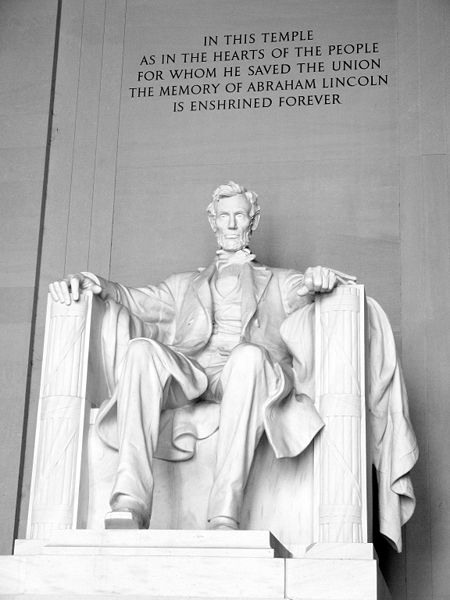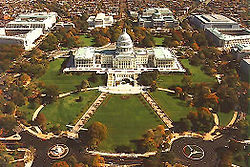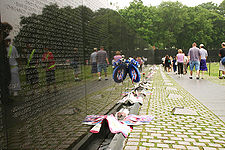
- •Module 2. Modern realia of the united states of america (usa) geography of the usa
- •1. Geographical position of the usa
- •2. State symbols of the usa
- •2.1. The flag of the usa
- •2.2. The us coat of arms
- •2.3. The usa bird symbol
- •2.4. The usa national anthem
- •3. The usa physical geography
- •3.1. The usa major rivers and lakes
- •3.2. The usa major mountains ranges
- •3.3. The usa major cities
- •3.4. Weather and climate in the usa
- •3.5. Mineral resources of the usa
- •3.6. Demographics of the United States
- •4. The usa economic geography
- •5. Washington, d.C. – the capital city of the United States
- •Major sights of Washington, d.C.
- •Glossary
- •Comprehension
- •Self-Assessment
- •Further Reading
5. Washington, d.C. – the capital city of the United States
Washington, D.C. is the capital of the United States, founded on July 16, 1790. The City of Washington was originally a separate municipality within the Territory of Columbia until an act of Congress in 1871 effectively merged the City and the Territory into a single entity called the District of Columbia. It is for this reason that the city, while legally named the District of Columbia, is known as Washington, D.C. The city is located on the north bank of the Potomac River and is bordered by the states of Virginia to the southwest and Maryland to the other sides. The District has a resident population of 591,833.
Washington replaced Philadelphia as the nation’s capital in 1800.
The District has a total area of 177 km2, of which 159 km2is land and 18 km2(10.16%) is water. The District is no longer 260 km2due to the retrocession of the southern portion of the District back to the Commonwealth of Virginia in 1846. The District’s current area consists only of territory ceded by the state of Maryland. Washington is therefore surrounded by the states of Maryland to the southeast, northeast, and northwest and Virginia to the southwest.
Washington, D.C. is a planned city. The design for the City of Washington was largely the work ofPierre Charles L’Enfant, a French-born architect, engineer, and city planner who first arrived in the colonies as a military engineer withMajor General Lafayetteduring theAmerican Revolutionary War. In 1791, President Washington commissioned L’Enfant to plan the layout of the new capital city. L’Enfant’s plan was modeled in theBaroquestyle, which incorporated broad avenues radiating out from rectangles and circles, providing for open space and landscaping. In March 1792, President Washington dismissed L’Enfant due to his insistence on micromanaging the city’s planning, which had resulted in conflicts with the three commissioners appointed by Washington to supervise the capital’s construction.Andrew Ellicott, who had worked with L’Enfant surveying the city, was then commissioned to complete the plans. Though Ellicott made revisions to the original plans, including changes to some street patterns, L’Enfant is still credited with the overall design of the city. The City of Washington was bounded by what is nowFlorida Avenueto the north, Rock Creek to the west, and the Anacostia River to the east.
Major sights of Washington, d.C.
T heUnited States Capitolserves as theseat
of governmentfor theUnited
States Congress, thelegislative
branchof theU.S.
federal government. It is located inWashington,
D.C., on top ofCapitol
Hillat the eastern end of theNational
Mall. Although not in the geographic center
of the District of Columbia, the Capitol is theoriginby which the quadrants of the district are divided. Officially, both
the east and west sides of the Capitol are referred to as“fronts”.
Historically, however, the east front was initially the side of the
building intended for the arrival of visitors and dignitaries.
heUnited States Capitolserves as theseat
of governmentfor theUnited
States Congress, thelegislative
branchof theU.S.
federal government. It is located inWashington,
D.C., on top ofCapitol
Hillat the eastern end of theNational
Mall. Although not in the geographic center
of the District of Columbia, the Capitol is theoriginby which the quadrants of the district are divided. Officially, both
the east and west sides of the Capitol are referred to as“fronts”.
Historically, however, the east front was initially the side of the
building intended for the arrival of visitors and dignitaries.
The building is marked by its central domeabove arotundaand two wings, one for each chamber of Congress: the north wing is the Senate chamber and the south wing is the House of Representatives chamber. Above these chambers are galleries where visitors can watch the Senate and House of Representatives. It is an example of theneoclassical architecturestyle. The statue on top of the dome is theStatue of Freedom.
Underground tunnels (and even a private underground railway) connect the main Capitol building with each of theCongressional office buildingsin the surrounding complex. All rooms in the Capitol(540) are designated as either S (for Senate) or H (for House), depending on whether they are north (Senate) or south (House) of theRotunda.
T heWhite Houseis theofficial
residenceand principal workplace of thePresident
of the United States. Located at 1600Pennsylvania
Avenue NWinWashington,
D.C., it was built between 1792 and 1800 of
white-paintedAquia
sandstonein the lateGeorgian
styleand has been the executive residence
of every U.S. President sinceJohn
Adams. WhenThomas
Jeffersonmoved into the home in 1801, he
(with architectBenjamin
Henry Latrobe) expanded the building
outward, creating twocolonnadeswhich were meant to conceal stables and storage.
heWhite Houseis theofficial
residenceand principal workplace of thePresident
of the United States. Located at 1600Pennsylvania
Avenue NWinWashington,
D.C., it was built between 1792 and 1800 of
white-paintedAquia
sandstonein the lateGeorgian
styleand has been the executive residence
of every U.S. President sinceJohn
Adams. WhenThomas
Jeffersonmoved into the home in 1801, he
(with architectBenjamin
Henry Latrobe) expanded the building
outward, creating twocolonnadeswhich were meant to conceal stables and storage.
The White House is made up of six stories – the Ground Floor, State Floor, Second Floor, and Third Floor, as well as a two-storybasement. The termWhite Houseis regularly used as ametonymfor theExecutive Office of the President of the United Statesand for the president’s administration and advisors in general. The property is owned by theNational Park Serviceand is part of thePresident's Park.
T he
Washington Monument(also known as Pencil)
is the most prominent structure in Washington, D.C. and one of
the city’s early attractions. It
was built in honor of George Washington, who led the country to
independence and then became its first President. The Monument is
shaped like an Egyptian obelisk and offers
views in excess of thirty miles. It was finished on December 6, 1884.
he
Washington Monument(also known as Pencil)
is the most prominent structure in Washington, D.C. and one of
the city’s early attractions. It
was built in honor of George Washington, who led the country to
independence and then became its first President. The Monument is
shaped like an Egyptian obelisk and offers
views in excess of thirty miles. It was finished on December 6, 1884.
The Lincoln Memorialstands at the west end of the
National Mall as a neoclassical monument to the 16thPresident. The memorial isdesigned byHenry Bacon, after ancient Greek temples.
It is surrounded by a peristyle of 38 fluted Doric columns,
one for each of the thirty six states in the Union at the time of
Lincoln’s death, and two columns in-antis
at the entrance behind the colonnade. The north and south side
chambers contain carved inscriptions of Lincoln’s
Second Inaugural Address and his Gettysburg Address. Lying between
the north and south chambers is t he
central hall containing the solitary figure of Lincoln sitting in
contemplation. The statue was carved in four years by the P
he
central hall containing the solitary figure of Lincoln sitting in
contemplation. The statue was carved in four years by the P iccirilli
brothers under the supervision of the sculptor, Daniel Chester
French. The statue of Lincoln and weighs 175 tons. The original plan
was for the statue to be only ten feet high, but this was changed so
that the figure of Lincoln would not be dwarfed by the size of the
chamber. A commission to plan a monument was first proposed in 1867,
shortly after Lincoln’s death. The design
for that plan called for six equestrian and 31 pedestrian statues of
colossal size, with ahugestatue of
Lincoln in the center.
iccirilli
brothers under the supervision of the sculptor, Daniel Chester
French. The statue of Lincoln and weighs 175 tons. The original plan
was for the statue to be only ten feet high, but this was changed so
that the figure of Lincoln would not be dwarfed by the size of the
chamber. A commission to plan a monument was first proposed in 1867,
shortly after Lincoln’s death. The design
for that plan called for six equestrian and 31 pedestrian statues of
colossal size, with ahugestatue of
Lincoln in the center.
That project was never started for lack of funds. Congress approved the bill to construct this memorial in 1910. Construction began in 1914, and the memorial was opened to the public in 1922. The Memorial is visited by millions of visitors each year and is the site of many large public gatherings and protests. Martin Luther King, Jr. delivered his famous “I Have a Dream”speechto a crowd by the Lincoln Memorial in 1963. Damaged over the years by heavy visitation and environmental factors, the Lincoln Memorial is currently undergoing a major restoration.
T heLibrary of Congressis thede
factonational
libraryof theUnited
Statesand the research arm of theUnited
States Congress. Located in three buildings
inWashington,
D.C., it is the largestlibraryin the world by shelf space and holds the largest number of books.
The head of the Library is theLibrarian
of Congress, currentlyJames
H. Billington.
heLibrary of Congressis thede
factonational
libraryof theUnited
Statesand the research arm of theUnited
States Congress. Located in three buildings
inWashington,
D.C., it is the largestlibraryin the world by shelf space and holds the largest number of books.
The head of the Library is theLibrarian
of Congress, currentlyJames
H. Billington.
C apitol
Hill, aside from being a metonym
for the United
States Congress,
is the largest historic residential neighborhood
in Washington
D.C., stretching
easterly in front of the U.S.
Capitol along wide
avenues. It is one of the oldest residential communities in
Washington, and with roughly 35 000 people in just under two square
miles, it is also one of the most densely populated.
apitol
Hill, aside from being a metonym
for the United
States Congress,
is the largest historic residential neighborhood
in Washington
D.C., stretching
easterly in front of the U.S.
Capitol along wide
avenues. It is one of the oldest residential communities in
Washington, and with roughly 35 000 people in just under two square
miles, it is also one of the most densely populated.
As a geographic feature, Capitol Hill rises in the center of the District of Columbia and extends eastward. Pierre L’Enfant, as he began to develop his plan for the new Federal City in 1791, chose to locate the “Congress House” on the crest of the hill, facing the city, a site that L’Enfant characterized as a “pedestal waiting for a superstructure”.
The Capitol Hill neighborhood today straddles two quadrants of the city, Southeast and Northeast, and a large portion is now designated as the Capitol Hill historic district. The name Capitol Hill is often used to refer to both the historic district and to the larger neighborhood around it. To the east of Capitol Hill lies the Anacostia River, to the north is the H Street corridor, to the south are the Southeast/Southwest Freeway and the Washington Navy Yard, and to the west are the National Mall and the city's central business district.
T heNational Mallis an open-areanational
parkindowntownWashington,
D.C.Oficially
termed by theNational
Park Servicethe National MallandMemorial Parks, the term commonly includes the areas that are
officially part ofWest
Potomac ParkandConstitution
Gardensto the west, and often is taken to
refer to the entire area between theLincoln
Memorialand theCapitol,
with theWashington
Monumentproviding a division slightly west
of the center.
heNational Mallis an open-areanational
parkindowntownWashington,
D.C.Oficially
termed by theNational
Park Servicethe National MallandMemorial Parks, the term commonly includes the areas that are
officially part ofWest
Potomac ParkandConstitution
Gardensto the west, and often is taken to
refer to the entire area between theLincoln
Memorialand theCapitol,
with theWashington
Monumentproviding a division slightly west
of the center.
V ietnam
Veterans Memorial. Deliberately
setting aside the controversies of the war, the Vietnam Veterans
Memorial honors the men and women who served when their Nation called
upon them. The designer, Maya Lin, felt that “the politics had
eclipsed the veterans, their service and their lives.” She kept the
design elegantly simple to “allow everyone to respond and
remember”.
ietnam
Veterans Memorial. Deliberately
setting aside the controversies of the war, the Vietnam Veterans
Memorial honors the men and women who served when their Nation called
upon them. The designer, Maya Lin, felt that “the politics had
eclipsed the veterans, their service and their lives.” She kept the
design elegantly simple to “allow everyone to respond and
remember”.
T he
Memorial Wall, designed byMaya
Ying Lin, is made up of two blackgranitewalls 75 meters long. The walls are sunk into the ground, with
the earth behind them.
he
Memorial Wall, designed byMaya
Ying Lin, is made up of two blackgranitewalls 75 meters long. The walls are sunk into the ground, with
the earth behind them.
I nscribed
on the walls with theOptima
typefaceare the names of servicemen who were either confirmed to be KIA
(Killed in Action) or remained classified as MIA (Missing in Action)
when the walls were constructed in 1982. They are listed in
chronological order, starting at the apex on panel 1E in 1959
(although it was later discovered that the first casualties were
military advisers who were killed by artillery fire in 1957), moving
day by day to the end of the eastern wall at panel 70E, which ends on
May 25, 1968, starting again at panel 70W at the end of the western
wall which completes the list for May 25, 1968, and returning to the
apex at panel 1W in 1975. Symbolically, this is described as a“wound
that is closed and healing”.
nscribed
on the walls with theOptima
typefaceare the names of servicemen who were either confirmed to be KIA
(Killed in Action) or remained classified as MIA (Missing in Action)
when the walls were constructed in 1982. They are listed in
chronological order, starting at the apex on panel 1E in 1959
(although it was later discovered that the first casualties were
military advisers who were killed by artillery fire in 1957), moving
day by day to the end of the eastern wall at panel 70E, which ends on
May 25, 1968, starting again at panel 70W at the end of the western
wall which completes the list for May 25, 1968, and returning to the
apex at panel 1W in 1975. Symbolically, this is described as a“wound
that is closed and healing”.
T he
Jefferson Memorial. Situated
on the South side of the Tidal Basin, in West Potomac park, theThomas
JeffersonMemorial is one of the cities most
picturesque landmarks. Dedicated in 1943, on the 200thanniversary of Jefferson’s birth, this
simple circular classical white marble monument is in keeping with a
style much favored by the third U.S. president, architect, scholar
and political thinker. At its center, a towering bronze portrait
statue (the plaster one, in position until after WWII, is in the
basement, too large to be removed intact) stands on a pedestal.
Panels are inscribed with excerpts of Jefferson’s
writing, including one that best sums up the man:“I
have sworn upon the alter of God eternal hostility against every form
of tyranny over the mind of man”. The
view from the steps is magnificent, especially at night when a halo
of blue light crowns the structure.
he
Jefferson Memorial. Situated
on the South side of the Tidal Basin, in West Potomac park, theThomas
JeffersonMemorial is one of the cities most
picturesque landmarks. Dedicated in 1943, on the 200thanniversary of Jefferson’s birth, this
simple circular classical white marble monument is in keeping with a
style much favored by the third U.S. president, architect, scholar
and political thinker. At its center, a towering bronze portrait
statue (the plaster one, in position until after WWII, is in the
basement, too large to be removed intact) stands on a pedestal.
Panels are inscribed with excerpts of Jefferson’s
writing, including one that best sums up the man:“I
have sworn upon the alter of God eternal hostility against every form
of tyranny over the mind of man”. The
view from the steps is magnificent, especially at night when a halo
of blue light crowns the structure.
T he
Franklin Delano Roosevelt Memorialin Washington DC is next
to the Tidal Basin.
he
Franklin Delano Roosevelt Memorialin Washington DC is next
to the Tidal Basin.
The Roosevelt Memorial dedicated on May 2, 1997 traces twelve years of American history through a sequence of four outdoor rooms. Each is devoted to one of President Roosevelt’s terms of office.
The memorial has several statues with one showing Roosevelt in a wheeled chair and another depicting him riding in a car during his first inaugural.

Pennsylvania Avenueis a street inWashington, D.C.joining theWhite Houseand theUnited States Capitol. Called“America’s Main Street”,it is the location of official parades and processions, as well as protest marches and civilian protests. Moreover, Pennsylvania Avenue is an important commuter route and is part of theNational Highway System.
